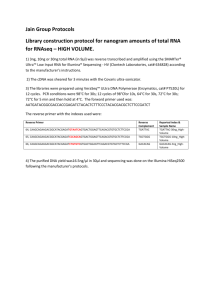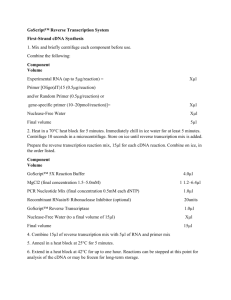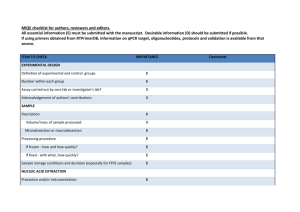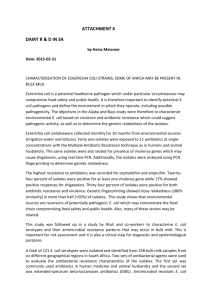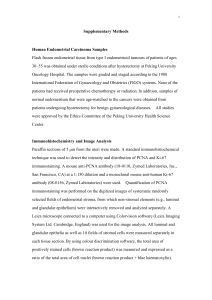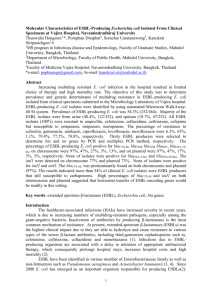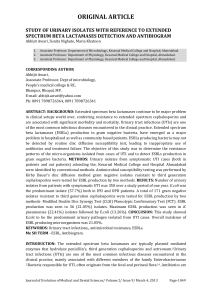file - BioMed Central
advertisement
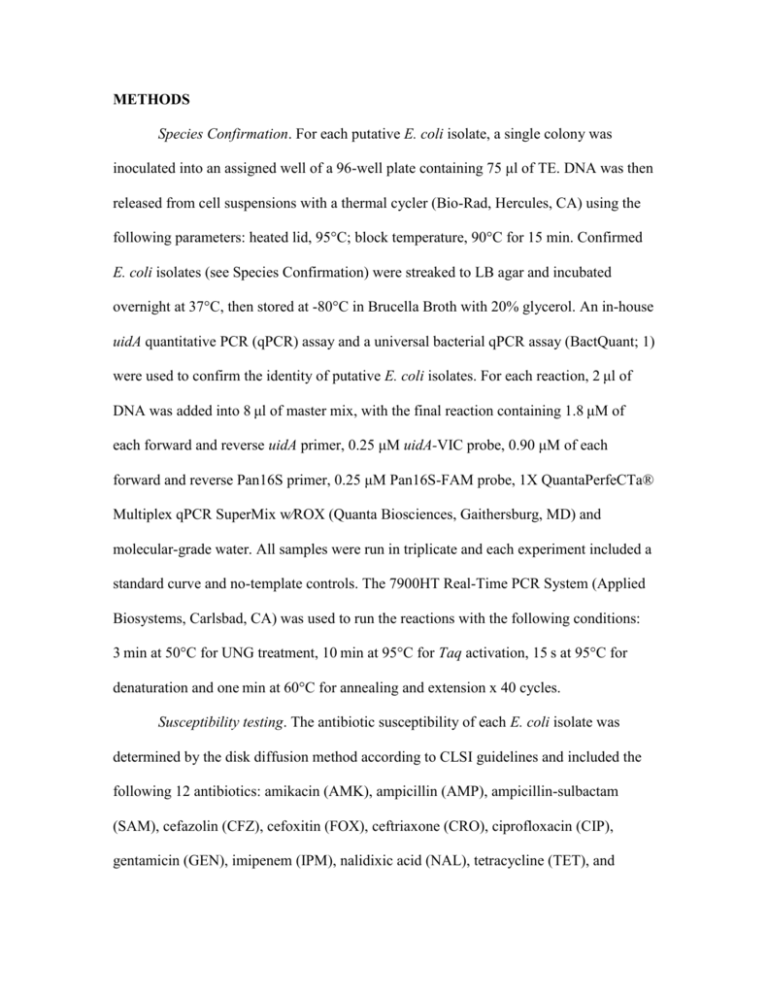
METHODS Species Confirmation. For each putative E. coli isolate, a single colony was inoculated into an assigned well of a 96-well plate containing 75 μl of TE. DNA was then released from cell suspensions with a thermal cycler (Bio-Rad, Hercules, CA) using the following parameters: heated lid, 95°C; block temperature, 90°C for 15 min. Confirmed E. coli isolates (see Species Confirmation) were streaked to LB agar and incubated overnight at 37°C, then stored at -80°C in Brucella Broth with 20% glycerol. An in-house uidA quantitative PCR (qPCR) assay and a universal bacterial qPCR assay (BactQuant; 1) were used to confirm the identity of putative E. coli isolates. For each reaction, 2 μl of DNA was added into 8 μl of master mix, with the final reaction containing 1.8 μM of each forward and reverse uidA primer, 0.25 μM uidA-VIC probe, 0.90 μM of each forward and reverse Pan16S primer, 0.25 μM Pan16S-FAM probe, 1X QuantaPerfeCTa® Multiplex qPCR SuperMix w⁄ROX (Quanta Biosciences, Gaithersburg, MD) and molecular-grade water. All samples were run in triplicate and each experiment included a standard curve and no-template controls. The 7900HT Real-Time PCR System (Applied Biosystems, Carlsbad, CA) was used to run the reactions with the following conditions: 3 min at 50°C for UNG treatment, 10 min at 95°C for Taq activation, 15 s at 95°C for denaturation and one min at 60°C for annealing and extension x 40 cycles. Susceptibility testing. The antibiotic susceptibility of each E. coli isolate was determined by the disk diffusion method according to CLSI guidelines and included the following 12 antibiotics: amikacin (AMK), ampicillin (AMP), ampicillin-sulbactam (SAM), cefazolin (CFZ), cefoxitin (FOX), ceftriaxone (CRO), ciprofloxacin (CIP), gentamicin (GEN), imipenem (IPM), nalidixic acid (NAL), tetracycline (TET), and trimethoprim-sulfamethoxazole (SXT). Isolates were classified as “susceptible”, “intermediate”, or “resistant” in accordance with breakpoint guidelines from the 2011 CLSI M1009 Tables 2A through 2J for E. coli; for statistical analyses “intermediate” and “resistant” isolates were grouped together. The 12 individual antibiotics used for susceptibility testing fell into seven different antibiotic classes: aminoglycosides (amikacin and gentamicin), carbapenems (imipenems), cephalosporins (cefazolin, cefoxitin, and ceftriaxone), folate pathway inhibitors (trimethoprim-sulfamethoxazole), penicillins and penicillin combinations (ampicillin and ampicillin-sulbactam), quinolones (nalidixic acid and ciprofloxacin), and tetracyclines (tetracycline). Isolates resistant to two or more classes of antibiotics were classified as multi-drug resistant (MDR). Extraintestinal Pathogenic E. coli (ExPEC) testing. E. coli isolates were tested for six ExPEC hallmark genes: papA, sfaE, kpsMII, papC, iutA, and afaC. For the first triplex qPCR, 2 μl of DNA was added into 8 μl of master mix, with the final reaction containing 0.50 μM of each forward and reverse afaC primer, 0.13 μM afaC-FAM probe, 0.10 μM of each forward and reverse papC primer, 0.10 μM papC-HEX probe, and 0.50 μM of each forward and reverse iutA primer, 0.13 μM iutA-RED probe, 1X QuantaPerfeCTa® Multiplex qPCR SuperMix w⁄ROX (Quanta Biosciences, Gaithersburg, MD) and molecular-grade water. For the second triplex reaction, 2μl of DNA was added into 8 μl of master mix, with the final reaction containing 0.10 μM of each forward and reverse papA primer, 0.13 μM papA-FAM probe, 0.50 μM of each forward and reverse kpsMII primer, 0.13 μM kpsMII-HEX probe, and 0.30 μM of each forward and reverse sfaE primer, 0.13 μM sfaE-RED probe, 1X QuantaPerfeCTa® Multiplex qPCR SuperMix w⁄ROX (Quanta Biosciences, Gaithersburg, MD) and molecular-grade water. The Roche Light Cycler 480 (Roche, Pleasanton, CA) was used to run the reactions with the following conditions: hot start at 95 °C for three min; amplification for 45 cycles of 95 °C for 15 s (ramp rate 4.8 °C/s), 55°C for one min (acquisition single, ramp rate 2.5 °C/s); followed by a cooling step at 40 °C for 10 s (ramp rate of 2.5 °C/s). Fluorescence signal was obtained by using Mutli Hydrolysis Probe setting for FAM (nm), HEX (nm), and RED (nm). E. coli isolates positive for two or more of the six hallmark virulence genes were classified as ExPEC.


